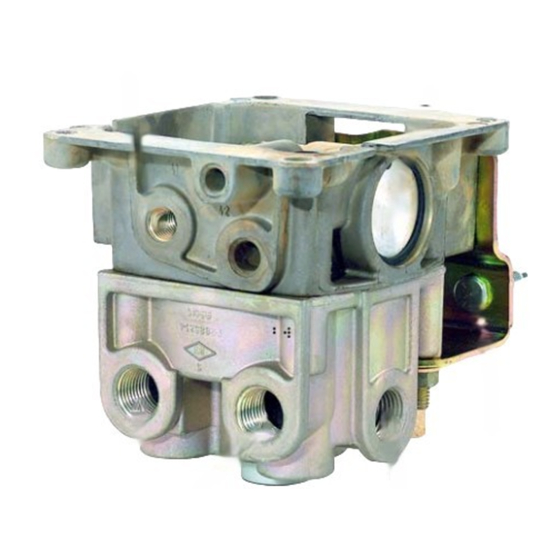BENDIX AR-1 ANTILOCK RELAY VALVE Посібник - Сторінка 2
Переглянути онлайн або завантажити pdf Посібник для Блок управління BENDIX AR-1 ANTILOCK RELAY VALVE. BENDIX AR-1 ANTILOCK RELAY VALVE 8 сторінок. Antilock relay valve

EC-15
™
ANTILOCK
CONTROLLER
TYPICAL
MOUNTING
BRACKET
™
FIGURE 2 - CR-15
ANTILOCK RELAY CONTROLLER
relay piston. The standard AR-1
crack pressure however with the addition of a various springs
beneath the relay piston higher crack pressures are
possible.
The AR-1
™
valve's internal components are interchangeable
™
with the R-12
and R-14
maintenance kit is used to service all three valves.
OPERATION
BRAKE APPLICATION
Brake application air enters the AR-1
encounters the exhaust diaphragm which flexes in response
to the incoming air, sealing the exhaust passage in the cover.
Air flows around the exhaust diaphragm and moves through a
passage in the cover to the top of the relay piston. In response
to air pressure, the relay piston moves into contact with the
exhaust portion of the inlet and exhaust valve. With the exhaust
passage sealed, continued movement of the relay piston
unseats the inlet portion of the inlet and exhaust valve, allowing
supply air from the reservoir to flow out the AR-1
ports to the antilock modulators and then to the brake
actuators. (Figure 3)
2
™
valve is offered with a 4 psi
™
relay valves therefore the same
™
valve's service port and
™
valve's delivery
HOLDING-BALANCED
The air pressure being delivered to the antilock modulators
and brake actuators is also present beneath the relay piston.
When the air pressure above and below relay piston is
equal, the piston moves slightly allowing the inlet valve to
return to its seat. The exhaust valve remains closed. With
both the inlet and exhaust valves closed, air pressure in the
antilock modulators and brake actuators is held stable and
neither increases nor decreases. (Figure 4)
EXHAUST - BRAKE RELEASE
When the brake application is released, air pressure in the
™
service port of the AR-1
and is exhausted. Air, from above the relay piston, flows back
through the cover to the exhaust diaphragm. The diaphragm
flexes in response to the returning air, sealing the service port
and opening the exhaust in the cover. With the exhaust
diaphragm blocking the service port, returning air flows out the
open exhaust. As air pressure is reduced above the relay piston,
pressure beneath it lifts the piston away from the exhaust
valve and opens the exhaust passage. Air from the antilock
modulators and brake actuators returns to the AR-1
and flows out the open exhaust. (Figure 5)
AR-1
™
ANTILOCK RELAY
valve returns to the foot brake valve
™
valve
